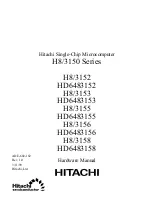
V
VDDA
VSSA
Touch
removed
t
Step N-1 Step N
Charge step Idle step
Extended
Pen-down
Usage Notes and Known Design Exceptions to Functional Specifications
•
The first workaround is implemented by configuring the Charge step exactly like the
Idle step, where the internal strong pull-up is not turned on. This workaround will
remove the strong pull-up on the analog input during the Charge step and leave only
the internal weak pull-up. The weak pull-up is not strong enough to effect the normal
Pen-down voltage. Therefore, the voltage applied to the analog input will not rise and
cause the TSC to generate a false Pen-up interrupt. There is a drawback to this
approach; this workaround will cause the Pen-down event to remain active until the
weak pull-up turned on in the Idle step charges the touchscreen capacitance, as
shown in
Figure 6. Pen-down Remains Active in Idle Step
•
Another method is available for 4-wire touchscreen implementations. It this case, it is
possible to enable and configure one of the 16 steps to emulate the Charge step with
the strong pull-up turned on as the step before the actual Charge step that has been
configured like the Idle step with the strong pull-up turned off. The advantage of this
implementation is that you are able to charge the touchscreen quicker and avoid the
possible false Pen-down interrupts. The disadvantage is that you lose one of the 16
programmable steps and during this step there will be a garbage result stored in the
FIFO. You will need to set the Step_ID_tag bit in the CTRL register so that you can
identify the garbage result in the FIFO and discard it.
33
SPRZ360F – October 2011 – Revised November 2013
Sitara™ AM335x ARM
®
Cortex™-A8 Microprocessors (MPUs) (Silicon
Revision 2.1, 2.0, 1.0)
Copyright © 2011–2013, Texas Instruments Incorporated







































